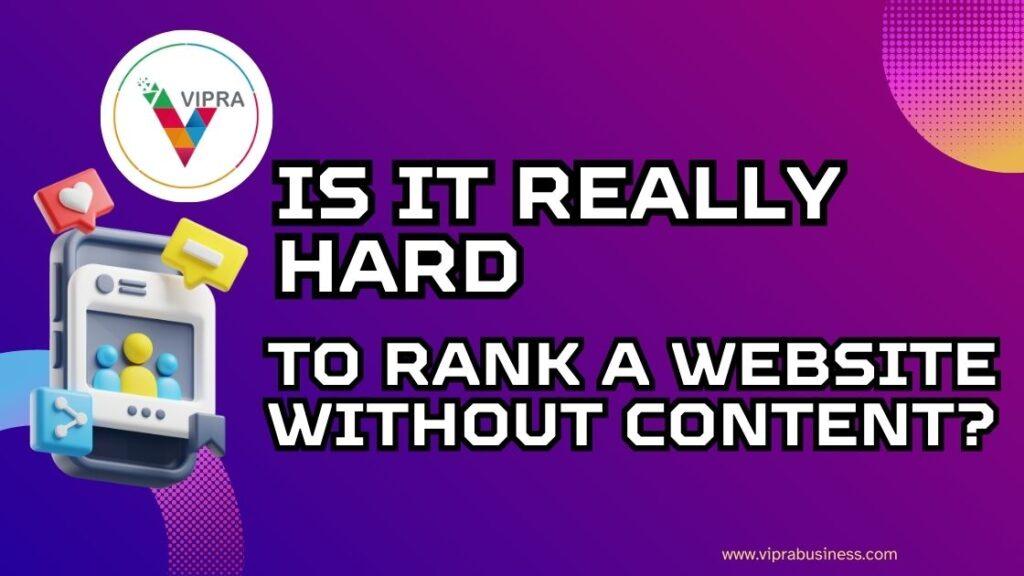It doesn’t matter how many links you have. If everyone lands on your site and you’re ranking number one and they click the back button. It tells Google that the site sucks and they should rank it lower.
Vipra Business is a pioneer in Google SEO. And in this article, we are going to talk about how to master Google SEO and give a boost to your business by discarding the high-demanding ads because paid ads are only getting more and more expensive and difficult.
There was a way to make money from paid ads for a very, very long time, just like SEO, which was much more manageable 10 or 15 years back. But with time, it has evolved into a rigid and complex process. But it still produces results just like advertising without any cost.
Over the years, you get to learn how to optimize your conversions, your funnels, or up-sell and down-sell and all these things help you get a better ROI over time. New platforms are going to keep emerging. But these skills will remain static.

Is it really hard to rank a website without content?
You probably have tons of content in your mind and you probably have executed some of your ideas as Video content or Text-based content. Here we are focusing on text-based content because videos can be ranked but typically whenever you do a Google search, it’s mainly text-based websites that you’re landing onto. So the first thing you’d want to do is give away the farm.
Giving away the farm means thinking about everything that you’re charging for. Educate people, post through text-based blogs, and give that away on their website. Suppose, you have a $10,000 coaching, and included in that is a training program with a bunch of modules, a bunch of lessons. Now if we take a percentage of that, or pretty much type all of that up break it up across lots of different articles, and put it on the web. There would be several variations of it which it doesn’t have to be.
You have to give away your most valuable content for free if you’re looking to rank.
How will I know which topics from my valuable content are going to pull well or not?
It’s a very common question that most beginners have in their minds. Well as a solution to this, there are free tools like Ubersuggest where you can end up typing any keywords and you’re going to get more specific.
Your content must have a three-pronged approach. The three-pronged approach is something called the “offer triangle” where the client’s results are at the top. Next to that, there is lifestyle and scalability. So you’ve to offer something that can satisfy those three things.
You can go to sites like Ubersuggest and type the keywords. It’ll tell you the popularity of that term plus it’ll give you thousands and thousands and thousands of other suggestions. It would give you other long-term variations of it. So now you have a list of a ton of keywords within your industry that people are searching for. Look for the ones with a high search volume because that means people are searching for them monthly.
And look for the ones that have a high CPC (cost-per-click). Higher the CPC, the better that keyword; because people are getting more conversions. now all you have to do is create content around those keywords, assuming it’s relevant to the products and the services you’re offering. And then you put that up on the internet. That’s the first step.
How and where to start from?
There are a lot of tools in the market that you can use to do your keyword research. We prefer using Ubersuggest and I will let you know how we use the tool for keyword ideas and research. With Ubersuggest, you can put in your domain name and it’ll tell you out of the list of keywords it’ll filter the ones that you have the highest probability of ranking for right now based on what you’ve done so far. Then you would create text-based content and put those blog posts on your website. You could use things like ChatGPT and Bard or the Ubersuggest AI Writer. You still should have a human to modify the content because your content needs to have E-E-A-T. What that stands for? Experience. Expertise. Authority, and Trust. And Google breaks that down.

They want your content to be unique and to stand out. They don’t want it to be regurgitated information that can already be found on the web. If you can end up creating really, really unique content that stands out and is super helpful, it’s more likely to rank. And then what you’ll need to do is, you need to get some social shares to your articles. So share it on your social profiles. And you can also reach out to other people who share similar content on Twitter and other social networks and ask them to share content and maybe you reciprocate and share their content.
Then, you need to get links. Links are one website linking to your website. Without other people linking to your website, you’re not going to rank as well. In Ubersuggest or any other tool of your choice, there’s a report called the Backlink Opportunity Report. You put in a few of your competitors and if you don’t know your competitors, just Google the terms you’re trying to rank for. You’ll see who’s at the top and you can put in your domain name and a few of your competitors. And in this Backlink Opportunity report, you first start with your domain name and then when you put in your competitors, It’ll give you boxes for your competitors. It’ll show you everyone who’s linking to your competitors but not you.
See if someone links to one of your competitors, they may be biased and they may like them and they may not link to you. If someone links to two, or three of your competitors, the chances are they like your industry. They don’t care about a specific competitor and they’re open to linking anyone in your space. You’d head up those sites and talk to them about how you have better content, more thorough. And they’re already linking to a few, how you can get them to link to you, and why it provides more value? And over time you’ll build some links. And what you’ll find in this process is you’ll start ranking higher.
Now there are some on-page SEO issues that most sites have. In the Ubersuggest report, there’s also a site audit report, in which you put in your URL, from where you get to know all the basic stuff you need to fix. So that way you can rank higher from a code perspective.
At this point, you just create at least three articles a week. If you do this for a year, you’ll start seeing some really good traffic. What you’ll notice though is as you get more traffic, you may not get more conversions.
We would just go to Fiverr and just buy a bunch of backlinks and it worked. I’m aware that that’s far from the truth now. What I’ve just described is very helpful but sounds very manual. Sadly there isn’t any way to automate this and leverage your time better than reaching out manually to all these different competitor’s sites. You have to just create amazing content, reach out to them, and get links. There are some other ways you can generate links. Like, you can create infographics. People are more likely to link to infographics from what we see. You can use Canva to create them. Infographic is just a visual that breaks down the story.
I’m trying to tell you that you can also create free tools. They’re easier to generate links too
You can also use sites like CodeCanyon to buy tools that you can white label and put on your site for under 100 bucks, maybe 50 bucks. And these tools over time will help build links as well. You just got to find tools within your space. But on sites like CodeCanyon, there are tools in almost every space. Now the game is we want high-value backlinks but perhaps fewer of them than just trying to get thousands and thousands of backlinks just for the sake of having a backlink.

Create enough content, add enough value and people link to it. This is like a conference. If you get sh*t content, are people going to come back next year? Nope. It’s the same with the internet. If you create good content, people will come back they’ll be loyal, they’ll give you their email address, they’re more likely to convert, they’ll link to you they’ll share your content, all that stuff.
So how many backlinks would I be expecting to generate over what period? And then when would it start to kick in?
Don’t worry about the number. It will be slow and steady. You may trickle in and get a few a week but after doing it for a year, your few weeks may turn into five or 10 a week. And it just adds up over time. You don’t need quantity to rank, you just need quality content. For the best user experience put the user first, and do what’s best for them. And in the longer run, you should start ranking higher and higher assuming you’re doing the other factors as we mentioned.
Can I still leverage my time by just hiring a VA to do that?
Not a VA, but someone who has a little bit more experience and someone who specializes in it. They’re going to have much more success than a VA. Just because of their knowledge of those competitors. Maybe they’ve sent out enough emails for link building so they know what has a better success rate. They know what kind of content converts better, things like that.
You have to focus on the text that you are putting in there and how long and things like that. But before we move on from thinking outside of that, outside of the backlinks, are there any other factors that we want to incorporate in our article that help rank? We talked about finding some keywords, some high-value ones, and competitive ones. Naturally, you’ll have the keywords in the article without forcing it. And you don’t need to emphasize how many times or anything like that. But you got the main factors on the page. I mentioned earlier that the site auto-report will help; backlinks and content. Those are the main three areas.
Conclusion
Just keep in mind that you have to provide a good experience to your customer and if you don’t, your customers are going to click the back button and go on to the next article. It doesn’t matter how many links you have. If everyone lands on your site and you’re ranking number one and they click the back button, it tells Google, this site sucks and they should rank it lower.
For more SEO tips, follow us on Facebook, Instagram, and Twitter.


